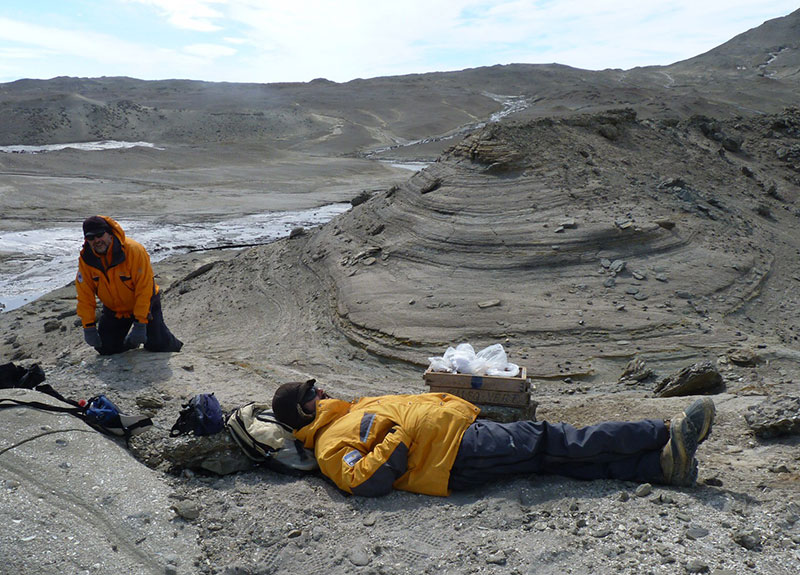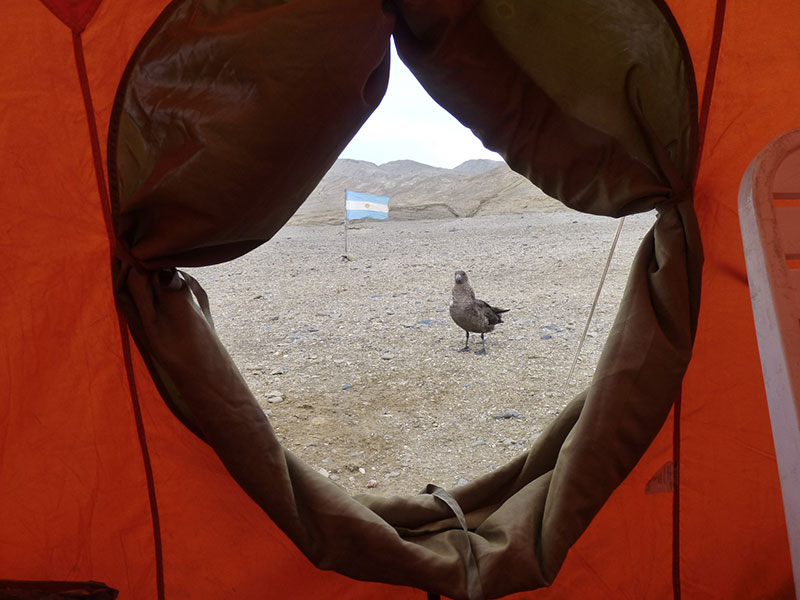
Dr. Carolina Acosta Hospitaleche is over 3,000 kilometers (2,000 miles) away from home, on an island off the coast of Antarctica. She and her team have flown across the ocean to a research base, received supplies from a dedicated research logistics team, flown once more in a helicopter to their camp site, and assembled the tents and radio system that will be their lifeline in the event a storm hits. Now they are making the most of their time in the field, taking advantage of the relatively hospitable summer weather with the knowledge that any fossils left at the surface will likely not survive the harsh winter storms. As she digs through the sediment of the La Meseta Formation, from about 10 million years after the extinction of the non-avian dinosaurs, she stumbles on a claw large and curved enough to make any Velociraptor blush. Dr. Acosta Hospitaleche recognizes what she’s found immediately: a terror bird.
 Reconstruction of the Eocene environment in Antarctica including marsupials, hooved mammals, birds of prey, and the newly-described terror bird. Artwork by Lic. M. Charnelli, commissioned as Figure 10 in the new paper.
Reconstruction of the Eocene environment in Antarctica including marsupials, hooved mammals, birds of prey, and the newly-described terror bird. Artwork by Lic. M. Charnelli, commissioned as Figure 10 in the new paper.
This is not the first claw from a “terror bird,” a term used to refer to several groups of large and usually flightless birds, Dr. Acosta Hospitaleche has uncovered. “A decade ago, we unearthed a fossil which strongly resembled a terror bird claw but, unfortunately, was poorly preserved, hindering our progress in its study,” she recounts. She and her team were understandably cautious, as there have already been four instances of fossils thought to be Antarctic terror birds turning out to be from unrelated bird groups. But with this new specimen, Dr. Acosta Hospitaleche was confident she had the real thing. Her only problem was determining exactly which terror bird the new find was related to; the specimens defied classification. At the height of her struggle, her lab was visited by Dr. Washington Jones, an expert in terror bird claws. She reached out to Dr. Jones and he was equally excited by the claws her team had uncovered. The two formed a partnership to research the exciting new find.
A new paper in Palaeontologia Electronica, headed by Dr. Acosta Hospitaleche and Dr. Jones (researchers at the Museo de La Plata and Universidad de la República, respectively), describes the talons of these terror birds. The claws either belong to a member of the family Phorusrhacidae, the group most frequently meant by the common name “terror bird,” or a very close relative. “Since we do not know other elements of the skeleton, we prefer to be cautious in the identification of the remains. We can assure that they are phororracoidal birds, that is, Phorusrhacidae or another seriema-like bird closely related to Phorusrhacidae,” Dr. Acosta Hospitaleche notes.
 Dig site where the new fossils were found on Seymour Island, West Antarctica. Dr. Acosta Hospitaleche’s colleagues Sergio Santillana (left) and Javier N. Gelfo (right) are surrounded by fossils, both bagged to bring back to Argentina and littering the ground. Picture provided by Carolina Acosta Hospitaleche.
Dig site where the new fossils were found on Seymour Island, West Antarctica. Dr. Acosta Hospitaleche’s colleagues Sergio Santillana (left) and Javier N. Gelfo (right) are surrounded by fossils, both bagged to bring back to Argentina and littering the ground. Picture provided by Carolina Acosta Hospitaleche.
Another reason the authors remain cautious about referring the new bones to Phorusrhacidae is that they are older than every other agreed-upon phorusrhacid fossil. Determining the place of origin for a group of animals is no easy task, and often highly swayed by where the oldest fossils are found. While the team need more material to be sure of these birds’ exact affinities, researchers interested in terror bird origins will likely be turning their gazes even further southward in the coming years.
 The terror bird claws described in the new study, from Seymour Island, West Antarctica. Scale bar = 1 cm. Figure 4 in the new paper.
The terror bird claws described in the new study, from Seymour Island, West Antarctica. Scale bar = 1 cm. Figure 4 in the new paper.
Perhaps the study’s most dramatic proposal is that terror birds may have served as apex predators in Eocene Antarctica. Until now, this time and place were considered oddly devoid of large predators. “Large continental predators were missing in the Antarctic assemblages. We only knew a diurnal raptor among birds, and small insectivorous marsupials. We never found a large carnivore, until now,” Dr. Acosta Hospitaleche explained.
Still, this ancient ecosystem has secrets left to be revealed. “The Antarctic islands undergo significant erosion, unveiling new fossils annually. The continuous exposure of fossils due to erosion presents a unique opportunity for us to uncover more about the ancient ecosystems of Antarctica,” said a hopeful Dr. Acosta Hospitaleche. The Argentinian Antarctic campaigns occur yearly, so more exciting finds are likely on their way.
 A living terrestrial avian predator in Antarctica, the Brown Skua. These birds are known to steal food from a vast array of animals in Antarctica, including visiting humans. In this author’s opinion, fitting heirs to the terror birds’ throne. Picture provided by Carolina Acosta Hospitaleche.
A living terrestrial avian predator in Antarctica, the Brown Skua. These birds are known to steal food from a vast array of animals in Antarctica, including visiting humans. In this author’s opinion, fitting heirs to the terror birds’ throne. Picture provided by Carolina Acosta Hospitaleche.
Dr. Acosta Hospitaleche and Dr. Jones stress that this work could never have been done alone, extending thanks to their colleagues Daniel García López, Facundo 'Pelu' Irazoqui, and, particularly, Javier N. Gelfo.
This study is titled ‘Were terror birds the apex continental predators of Antarctica? New findings in the early Eocene of Seymour Island’ and was authored by Dr. Carolina Acosta Hospitaleche (Museo de La Plata and CONICET, Argentina) and Dr. Washington Jones (Universidad de la República, Uruguay).
To discover more about this research, you can read the full publication here: https://doi.org/10.26879/1340

